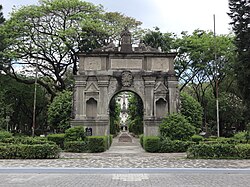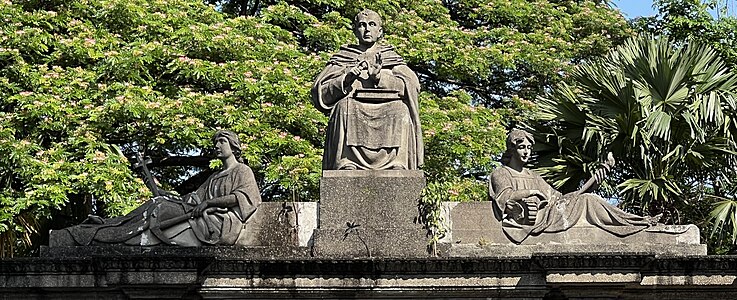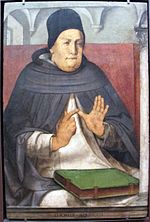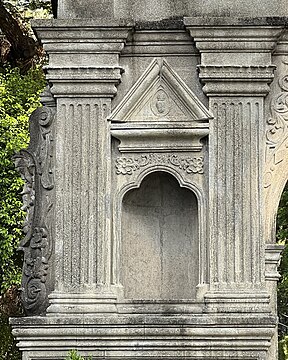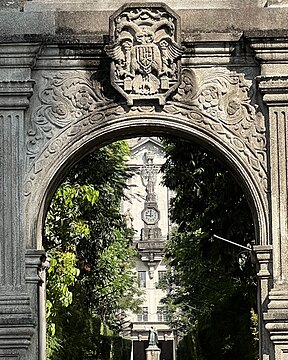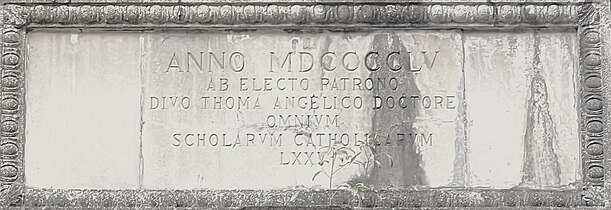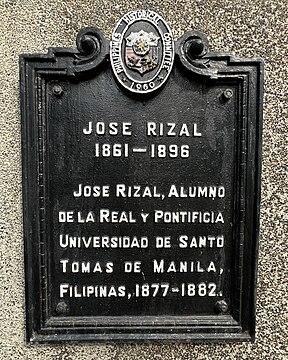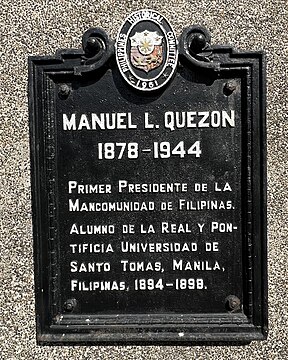
The University of Santo Tomas, officially the Pontifical and Royal University of Santo Tomas, Manila or colloquially as USTè, is a private, Catholic research university in Manila, Philippines. Founded on April 28, 1611, by Spanish friar Miguel de Benavides, third Archbishop of Manila, it has the oldest extant university charter in Asia and is one of the world's largest Catholic universities in terms of enrollment found on one campus. It is the main campus of the University of Santo Tomas System that is run by the Order of Preachers.

The University of Santo Tomas Faculty of Medicine and Surgery (USTFMS) is the medical school of the University of Santo Tomas, the oldest and largest Catholic university in Manila, Philippines.

The University of Santo Tomas–Legazpi, also referred to by its acronym UST–Legazpi or USTL, is a private, Catholic basic and higher education institution run and owned by the Philippine Dominican Province of the Order of Preachers (OP) in Legazpi City, Philippines. It was founded by Buenaventura de Erquiaga in 1948 and named Legazpi Junior Colleges.

The University of Santo Tomas in Manila, Philippines marks a variety of traditions largely influenced by the Spanish and Filipino Dominican culture. Many are annual events, such as religious assemblies marking the start and end of the academic year, a welcome walk for new students, as well as intercollege sport competitions and talent exhibitions. Christmas is celebrated in a month-long festivities culminated by the UST Paskuhan. Many Roman Catholic feast days are also celebrated.

The University of Santo Tomas is one of the oldest existing universities and holds the oldest extant university charter in the Philippines and in Asia. It was founded on April 28, 1611, by the third Archbishop of Manila, Miguel de Benavides, together with Domingo de Nieva and Bernardo de Santa Catalina. It was originally conceived as a school to prepare young men for the priesthood. Located Intramuros, it was first called Colegio de Nuestra Señora del Santísimo Rosario and later renamed Colegio de Santo Tomás in memory of Dominican theologian Saint Thomas Aquinas. In 1624, the colegio was authorized to confer academic degrees in theology, philosophy, and arts. On November 20, 1645, after representations by Vittorio Riccio, Pope Innocent X elevated the college to the rank of a university and in 1680 it was placed under royal patronage.
The Pontifical and Royal University of Santo Tomas (UST) Quadricentennial Celebration took place from December 18, 2009 to January 27, 2012. The agenda before the quadricentennial year in 2011 included the introduction of new academic programs, improvements in the university's infrastructure, and other projects to raise UST's national and international prominence and promote its role as a social catalyst.
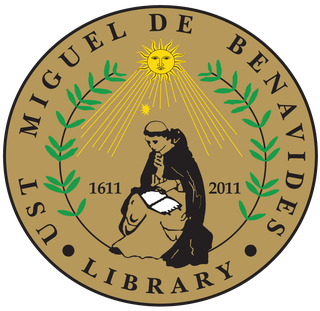
The Miguel de Benavides Library, also known as the University of Santo Tomas Library, is the main academic library of the University of Santo Tomas. The library has been in continuous service and its collection antedates the existence of the university itself.

The Rector Magnificus of the University of Santo Tomas is the highest-ranking officer and chief administrator of the University of Santo Tomas (UST), the oldest and the largest Catholic university in Manila, Philippines. The rector typically sits as chief executive and chair of the university board of trustees. He exercises policy-making as well as general academic, managerial, and religious functions over all university academic and non-academic staff. His term lasts for four years and he is qualified for re-election for two or more terms.
This is a timeline of the history of the Pontifical and Royal University of Santo Tomas, the oldest university in Asia, comprising important events of the history of the university and of the development of Philippine higher education in general. To read about the background to these events, see History of the University of Santo Tomas. See also the history of the Rector Magnificus of the University of Santo Tomas, and the Santo Tomas Internment Camp

Herminio Dagohoy, O.P., is the 96th Rector Magnificus of the University of Santo Tomas (UST), the oldest and the largest Catholic university in Manila, Philippines.
The University of Santo Tomas in Manila, Philippines has 22 colleges and 3 secondary school departments. The colleges are interdependent academic constituents of the university that offer undergraduate and graduate programs. Historically, the colleges are named as Faculty, College, Institute, School, or Conservatory. There are 19 colleges that offer civil courses and 3 faculties that also offer ecclesiastical programs.

The Benavides Monument is a memorial in the University of Santo Tomas in Manila, Philippines built to commemorate the founder of the University of Santo Tomas, Miguel de Benavides. Located in the Plaza Benavides in front of the UST Main Building, the monument consists of a bronze statue of Benavides rising on top of a granite pedestal. The present monument was unveiled in 1946.
The Thomasian Welcome Walk (TWW) is an annual event of the University of Santo Tomas in Manila, Philippines. Freshmen walk through the Arch of the Centuries, a monument that served as the original doorway to the first campus of the university in Intramuros.
The University of Santo Tomas System is a network of private schools that belong to the Philippine Dominican Province of the Order of Preachers. The system is composed of its six campuses at Manila, Legazpi, General Santos City, Iloilo City, Santa Rosa, and Quezon City.
The University of Santo Tomas General Santos is a private, Catholic higher education institution in General Santos, Philippines. The UST General Santos is the first UST Campus in Visayas and Mindanao. It is an extension campus of the University of Santo Tomas in Manila.
University of Santo Tomas Santa Rosa is an upcoming university in Santa Rosa, Laguna, Philippines. It is one of the five campuses in the University of Santo Tomas System. The new campus is envisioned to intensify the research activities of UST Manila by becoming a technological and innovative hub in Laguna.

The Plaza Benavides, also known as Benavides Park or Benavides Garden in Manila, Philippines is a landscaped park located in the University of Santo Tomas. It contains the Benavides Monument, built to commemorate the founder of the university, Miguel de Benavides.

The Plaza Intramuros is a park located in the University of Santo Tomas in Manila, Philippines. It contains the Arch of the Centuries, Fountain of Wisdom, and Fountain of Knowledge.
